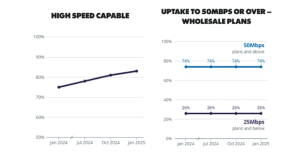How Australia Invented Global Connectivity But Left Citizens Behind

Figure 1:Poor Internet connection
“High-speed, stable and affordable internet” has long been a core infrastructure in countries. In Australia, the country that ‘invented Wi-Fi’, connectivity and network equity are falling behind. According to the Speedtest (2025), Australia is ranked 82nd in the world for average fixed broadband speeds, lagging behind many developing countries. At the same time, Australia’s average internet costs are as high as around A$70 per month, among the highest in the developed countries (P, 2023).
This is not due to a lack of technology. In fact, the core patented technology for Wi-Fi was first developed by Australia’s Commonwealth Scientific and Industrial Research Organisation (CSIRO) in 1992 (CSIRO, 2020). Ironically, today many residents of the country that originated the technology continue to rely on old copper wire networks (FTTN). This decision was intended to ‘save budgets’, but sacrificed network quality, ultimately leading to Australia’s ‘slow network predicament’.
“The parliamentary inquiry into NBN cost blowouts revealed that the initial transition to the multi-technology mix—while promoted as a budget-saving measure —ultimately required additional expenditures of approximately $15 billion while delivering inferior outcomes (The Guardian, 2015). Recent announcements of fibre upgrades essentially represent a return to the original FTTP vision, but with a decade of delays and additional costs, according to telecommunications policy analysts (ABC, 2025).”
The consequences of these policy decisions have not affected all Australians equally. According to Law (2025), residents in some rural areas experience broadband speeds up to 90% slower than their urban counterparts. The digital divide extends beyond geography to socioeconomic factors as well. The NBN Co’s 2025 upgrade announcement creates a system where access to quality infrastructure requires both awareness of upgrade options and the financial capacity to purchase premium plans which will effectively institutionalizing a two-tier internet system in Australia (NBN, 2025).
Although NBN Co has announced an upgrade plan in 2025 that will allow 95% of FTTN areas to apply for FTTP upgrades, this will be subject to customers choosing a high-speed plan of 100 Mbps or more and applying for it voluntarily (NBN, 2025). This digital equity crisis particularly impacts three key demographics: rural communities relying on fixed wireless or satellite connections; renters who cannot request infrastructure upgrades to properties they don’t own; and low-income households unable to afford the 100Mbps or faster plans required to trigger FTTP upgrades under NBN Co’s current policy (NBN, 2025). For these Australians, the technological innovation that their country pioneered remains frustratingly out of reach in their daily lives.

Figure 2: A table from NBN showing the percentage of users on different plans
Proposed Interview Subjects
- A student whose online learning is affected by unstable internet
- A social media content creator whose work is affected by slow upload speeds (active on platforms such as XiaoHongShu)
Target Publication
This story will be pitched to The Guardian Australia, a platform that focuses on infrastructure, digital justice, government accountability and social justice issues, where structural policy commentary is interwoven with personal stories.

Be the first to comment